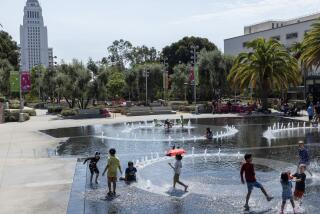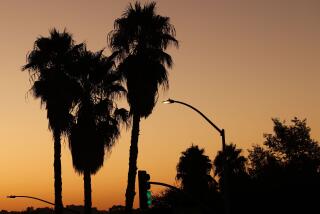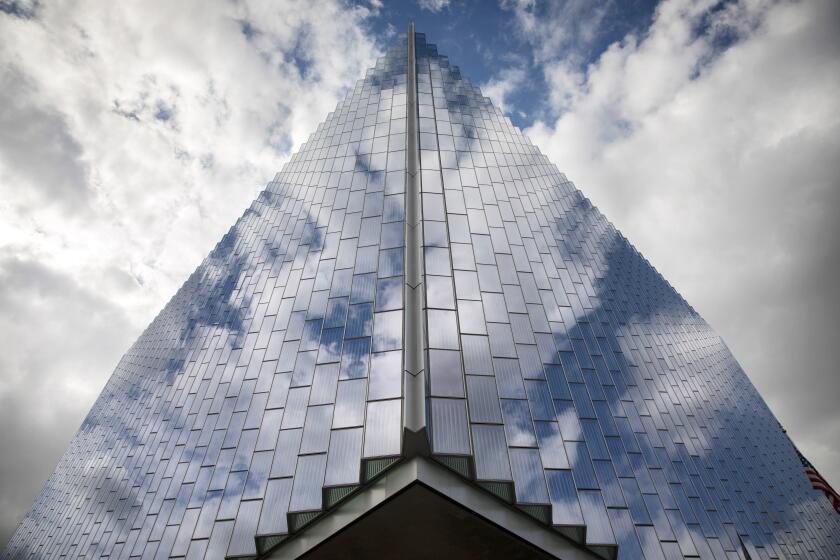The Word for the Weather: ‘Excessive’
Playgrounds emptied, pools overflowed and the hum of the noble air conditioner echoed over the land as another Southern California summer settled into high gear Monday with more record-breaking heat.
By midafternoon, the temperatures had easily topped 100 degrees in the inland valleys, and the National Weather Service had issued a rare “excessive heat” advisory. Forecasters said people should stay out of the afternoon sun through Wednesday, especially if they are elderly.
The Weather Service warned that the level of ultraviolet radiation was so high that a fair-skinned person couldn’t expect to spend more than four minutes in the sun without getting burned. School classes let out early in some parts of the region. And the Automobile Club of Southern California cautioned motorists to check their cars’ belts and batteries and coolant tanks.
It was the second consecutive day of triple-digit heat after a cooler-than-usual June and July.
And it was the second day in a row that records were broken in Chatsworth and Pasadena. Monday’s top mark of 108 degrees in Chatsworth broke the old record for the date, set in 1969, by five degrees. The high of 103 in Pasadena beat the old mark, set in 1979, by four degrees.
And in Woodland Hills, Monday’s 104-degree heat made it the hottest Aug. 4 in 14 years.
Similar temperatures are expected today.
Meteorologists blamed a high-pressure system that has hovered over the West Coast since the weekend and is not expected to abate until week’s end.
For East Los Angeles snow-cone vendor Jose Hernandez, this was good news.
“First June, then July, and now--finally--el calor,” he exulted, pushing his cart down Soto Street.
But most Southern Californians sided with Hernandez’s customer, Marta Bravo, 28.
“Ay, two days of this heat is already too much,” the sweltering woman moaned, biting into a frosty lemon ice.
How hot was it? Really hot.
*
So hot that a bunch of teenagers waiting for a bus in Pasadena at noon got singed by the bus bench and were forced to wait, squatting, in the shade of a small tree.
So hot that the Shetland ponies at a petting zoo in Koreatown were being rubbed down with wet rags, even in the shade.
So hot that at Pecan Park in Boyle Heights, the swings hung empty, while the nearby public pool was jammed. On a patch of scorched grass, recreation aide Jerry Miranda, 26, struggled to breath shape into an inflatable kiddie pool.
“Man,” he panted, dripping sweat, “we really need a good air pump.” At his feet, sticky children sat expectantly, too hot to speak.
The San Gabriel Valley was little better, with triple-digit temperatures in Pasadena and beyond. And in Orange County, the county courthouse had a particularly stultifying Monday morning: Someone had turned off the air conditioning over the weekend, and had forgotten to turn it back on.
Most of the 51 year-round schools in the San Fernando Valley have air conditioning because they are expected to operate through the hot summer months. But at least one of the schools, Liggett Street Elementary in Panorama City, has air conditioning in only about half its 37 classrooms.
Temperatures in the school’s hottest rooms approached triple digits Monday. In one kindergarten class, the mercury registered 95 degrees at 11 a.m. In the afternoon, the school paired students from hot rooms with those in air-conditioned classes.
Like campuses across the Valley, the school canceled outdoor physical education classes in the afternoon and had its 800 students do “quiet activities”--board games such as checkers--in the shade during lunch and at recess, following school district policies for protecting students against hot weather.
Principal David Sanchez said students would be allowed to go home half an hour early today, at 2:10 p.m., to escape the hot afternoon sun.
“Our teachers are having a hard time, but they are doing well under the conditions,” Sanchez said. “We have fans in the classrooms. Some kids are bringing water bottles.”
The award for the worst job in the Valley could well go to roofers, who poured hot tar under the scorching sun.
Kettles of roofing tar are heated to about 450 degrees, said Jim Dunn, president of A1 All American Roofing Co. When the tar hits the roof, it adds another 30 to 50 degrees to an already unbearable afternoon.
In Hidden Hills, foreman Richard Ramirez, 25, a colorful bandanna wrapped around his head to collect perspiration, estimated at midday that he and four other roofers had consumed about three gallons of water since starting work at 8 a.m. They took a two-hour lunch break to rest up for a hot afternoon.
There is historical precedent for a heat wave in the first week in August, even after an unusually cool summer.
In 1993, the San Fernando Valley had one of its coolest Julys on record, according to William Reid, a climatologist who collects weather data for the National Weather Service from his home station in Woodland Hills. The average high temperature at his station that July was a relatively mild 85.2 degrees. This year’s July average high, by comparison, was 89.8.
But the Valley likewise started to cook in 1993 just as August arrived. “On August 1, 1993, the high was 106,” Reid said. “So, a cool July doesn’t mean the weather will stay that way.”
Reid noted that at his station, the high on Monday was 104, a record for this date since he started taking readings for the National Weather Service in 1980. His previous high for August 4 was 102 in 1983.
John Sherwin, a meteorologist with WeatherData Inc., which provides weather information to The Times, said temperatures are expected to drop a bit by Thursday but will remain relatively high throughout the week. Clear and hot weather is forecast for the region, with highs from the upper 80s on the coast to 100 and above in the inland valleys.
The reason, he said, is a ridge of high pressure that has extended from the surface up into the upper atmosphere and that has inhibited the sea breezes that usually cool the region.
“Plus,” Sherwin deadpanned, “it’s August.”
Though August marks the last lap of summer in many parts of the nation, it is traditionally the height of summer here.
So, although Southern Californians tend to forget it from one year to the next, hot spells are routine. Nonetheless, the temperatures were sufficient to prompt the Weather Service to issue an unusual “excessive heat warning” for coastal and inland valleys in the Los Angeles area, and for all mountain areas of Southern California.
*
The warnings, which are in effect for the afternoon hours through Wednesday, are issued when the combination of heat and humidity reaches a dangerous index level. Meteorologists say only about half a dozen are issued each year; this is the first for 1997.
“It has to be pretty darn warm to have one of these things,” said Weather Service meteorologist Rob Krohn. “It basically means that you shouldn’t go outside, especially if you’re elderly. And if you do have to go out, drink a lot of water.”
Also contributing to this story were Times staff writers Shawn Hubler, Eric Malnic and David Colker and correspondents Kevin O’Leary, Claire Vitucci, Jack Leonard and Tracy Johnson.
More to Read
Sign up for Essential California
The most important California stories and recommendations in your inbox every morning.
You may occasionally receive promotional content from the Los Angeles Times.










